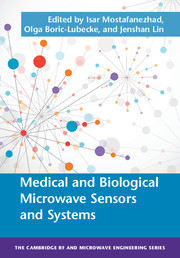Book contents
- Frontmatter
- Contents
- Contributors
- 1 Implantable Wireless Medical Devices for Gastroesophageal Applications
- 2 Embedded Wireless Device for Intracranial Pressure Monitoring
- 3 Wireless Intracranial Pressure Systems for the Assessment of Traumatic Brain Injury
- 4 Microwave Biosensors for Noninvasive Molecular and Cellular Investigations
- 5 Wearable Radar Tag Systems for Physiological Sensing/Monitoring
- 6 Physiological Radar Sensor Chip Development
- 7 Noise- and Interference-Reduction Methods for Microwave Doppler Radar Vital Signs Monitors
- 8 Biomedical Applications of UWB Technology
- Index
- References
1 - Implantable Wireless Medical Devices for Gastroesophageal Applications
- Frontmatter
- Contents
- Contributors
- 1 Implantable Wireless Medical Devices for Gastroesophageal Applications
- 2 Embedded Wireless Device for Intracranial Pressure Monitoring
- 3 Wireless Intracranial Pressure Systems for the Assessment of Traumatic Brain Injury
- 4 Microwave Biosensors for Noninvasive Molecular and Cellular Investigations
- 5 Wearable Radar Tag Systems for Physiological Sensing/Monitoring
- 6 Physiological Radar Sensor Chip Development
- 7 Noise- and Interference-Reduction Methods for Microwave Doppler Radar Vital Signs Monitors
- 8 Biomedical Applications of UWB Technology
- Index
- References
Summary
Introduction
Advances in low-power-consumption radiofrequency integrated circuits (RFICs), multifunctional integrated circuits, high-sensitivity sensing electrodes, biocompatible materials, and packaging techniques have made implants with wireless communication functionality and/or wireless charging capability more feasible and practical. However, wireless communication or wireless powering has not been widely used in implants. There are several challenges. The implant applications are typically disease oriented and implementation focused. The designs of implants have to address specific needs in the disease diagnosis or treatment modalities, which are strongly related to both electronic and mechanical parameters. The sensing modalities or therapy methods determine the electrical specifications, while the biological environments often present serious design constrains. The implementation has to suit clinical settings for safe, cost-effective, and relatively easy implantation procedures and, most important, the needs and comfort of patients in daily life.
It is obvious that integration of wireless communication functionality in implants can provide critical and increased capabilities in applications. The outbound communication brings sensor signals and device conditions to the reader outside the body. The sensors can monitor physiologic signals, such as blood pressure, intracranial pressure, core temperature, electrical signals of tissue or motility of organs, and biochemical conditions such as pH and certain protein or factor concentrations, of patients in vivo and in real time. In addition, the wireless communication can periodically report device conditions such as battery level, electrical resistance of electrodes, and current/voltage delivered to tissues. The inbound communication can be used for device reconfiguration, dosage setting, and condition probing. Bidirectional communication will be ideal for remote access of the implants, adding capabilities for real-time feedback as an integrated system between body and computer. The wireless closed-loop system also can provide real-time patient condition alerts, patient self-diagnosis using smart phones, and autonomous treatment-efficacy studies over a population of patients.
From the perspectives of patients, wireless communication removes the discomfort and inconvenience of tethered wires coming out of the body. Currently, the wires either go through small surgical openings in the body, such as for the extension wire from the head in deep brain stimulation, or an orifice, such as the nostril for stomach stimulation and multichannel intraluminal impedance tests or the urethra for bladder monitoring. The tethered wires connecting to the external electronic device, either a reader or a pulse generator, obviously bring some inconvenience to patients and sometimes pain, and they often limit patient mobility, hindering quality of life.
- Type
- Chapter
- Information
- Medical and Biological Microwave Sensors and Systems , pp. 1 - 39Publisher: Cambridge University PressPrint publication year: 2017
References
- 1
- Cited by



